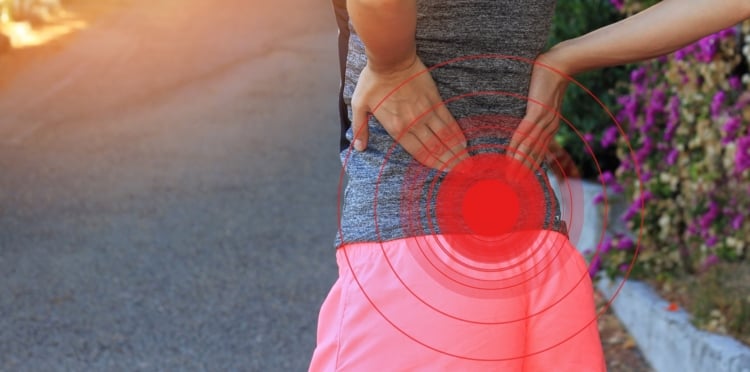Many people experience bloating, headaches, and abdominal pain during their period. Another common symptom that people experience during their period is lower back pain. This pain often occurs as part of premenstrual syndrome (PMS). Less commonly, it can occur as a result of diseases such as endometriosis.
-
Tracking cycle
-
Getting pregnant
-
Pregnancy
-
Help Center
-
Flo for Partners
-
Anonymous Mode
-
Flo app reviews
-
Flo Premium New
-
Secret Chats New
-
Symptom Checker New
-
Your cycle
-
Health 360°
-
Getting pregnant
-
Pregnancy
-
Being a mom
-
LGBTQ+
-
Quizzes
-
Ovulation calculator
-
hCG calculator
-
Pregnancy test calculator
-
Menstrual cycle calculator
-
Period calculator
-
Implantation calculator
-
Pregnancy weeks to months calculator
-
Pregnancy due date calculator
-
IVF and FET due date calculator
-
Due date calculator by ultrasound
-
Medical Affairs
-
Science & Research
-
Pass It On Project New
-
Privacy Portal
-
Press Center
-
Flo Accuracy
-
Careers
-
Contact Us
Lower Back Pain During Your Period: Causes, Diagnosis, and Treatment


Every piece of content at Flo Health adheres to the highest editorial standards for language, style, and medical accuracy. To learn what we do to deliver the best health and lifestyle insights to you, check out our content review principles.
Back pain caused by your period may range from mild discomfort to debilitating pain that interferes with daily activities. Back pain associated with your period can start a few days before it starts and get better after your period is over. This type of back pain is typically muscular and caused by hormonal changes. Let’s discuss how to manage lower back pain before, during, and after your period.
Causes of lower back pain during your period
Though the exact causes of lower back pain during periods aren’t yet fully understood, it’s usually associated with hormonal changes and their effect on ligaments in the spine. Researchers found that hormonal changes may influence collagen production, which can lead to ligament laxity, or loose ligaments. Loose ligaments can cause spinal instability and are sometimes accompanied by pain in the lower back.
Prostaglandins may also play a role. Prostaglandins are chemicals that cause many of the symptoms associated with menstrual discomfort. They are synthesized by many tissues in the body, including the endometrium (the tissue that lines the uterus). They stimulate contraction of the uterine muscles to shed the uterine lining during menstruation. Prostaglandins also cause cramps. Heavy contractions can lead to low-back pain, as the pain can radiate from the lower abdomen into the lower back.
People with increased prostaglandin activity may experience severe menstrual cramps and back pain during their period. Prostaglandins can also cause symptoms such as vomiting, headaches, and diarrhea that accompany painful menstruation (dysmenorrhea).
Lower back pain: period or pregnant?
Lower back pain can also be a symptom of early pregnancy. During pregnancy, the ligaments in the body naturally become softer and stretch to prepare for labor. This can put a strain on the joints of the lower back and pelvis, which can cause back pain.
Here are some of the differences between back pain from your period and back pain from pregnancy.
Period pain may start a few days before your period and subsides after your period is over. Low-back pain from early pregnancy may occur around the fourth week. Back pain may continue for weeks or months during pregnancy. Pregnancy may also come with other symptoms, such as light vaginal spotting or bleeding 10 to 14 days after conception (called implantation bleeding), nausea, and breast tenderness. If you’re pregnant and experiencing heavy vaginal bleeding, visit a health care provider immediately. It is especially important to notice these signs and symptoms if you have a history of early miscarriage.
Cramps and back pain can also be caused by an ectopic pregnancy. In this condition, a fertilized egg attaches itself somewhere other than inside the uterus, for instance, in the uterine tubes. The symptoms of an ectopic pregnancy include abdominal cramps, lower back pain, abnormal bleeding, nausea, and sometimes even shoulder pain. Some people may also have signs that are typical of an early pregnancy, such as sore breasts and nausea.
Lower back pain a week before your period
Lower back pain a week before your period may be a part of PMS. PMS is a combination of emotional, behavioral, and physical symptoms that occur before your period. PMS usually occurs in the second part of the luteal phase but can also begin right after ovulation and continue until the period starts. Lifestyle changes may help prevent the symptoms. If your symptoms are severe or unmanageable, talk to a health care provider.
Flo has launched video courses! What would you like to explore?

The Less Talked About Period Pain
Read medically reviewed articles on topics like this
Take a quiz
Find out what you can do with our Health Assistant
Cramping and back pain after your period: what does it mean?
Cramping and lower back pain may occur after your period for a few different reasons:
Ovulation — Lower back pain and cramping after your period may occur during ovulation, when the ovary releases an egg. Ovulation happens around the middle of the menstrual cycle. Ovulation pain may occur suddenly. It may last for a short time or for up to two days. It will usually get better on its own.
Endometriosis — In this condition, endometrial-like tissue grows outside its usual location (the uterus). With endometriosis, endometrial tissue may grow on the uterine wall, ovaries, uterine tubes, or tissue lining the pelvis. Endometriosis can cause lower back pain before and after your period. In addition to cramping and lower back pain, other symptoms of endometriosis include:
- Pain after and during sex
- Pain during urination
- Pain during bowel movements
- Infertility
- Bloating
- Excessive bleeding between or during periods
A health care provider may be able to treat endometriosis with medication or surgery.
Uterine fibroids — These are noncancerous growths that form in the uterine wall. They may cause lower back pain and other symptoms such as:
- Prolonged or heavy periods
- Difficult or frequent urination
- Irregular bleeding
- Abdominal cramping
- Constipation
- Infertility
- Leg pain
A health care provider may be able to treat uterine fibroids with medication or different types of surgery.
woman warming up outdoors

Track symptoms and patterns
Learn to spot patterns in your cycle as they can provide insight into underlying medical conditions

Cervical stenosis — In this condition, the cervical opening is very small and blocks the normal flow of menstrual blood. This can lead to increased pressure in the uterus, which can cause cramps. A health care provider may be able to treat cervical stenosis by dilating the cervix.
Pelvic inflammatory disease (PID) — PID is an infection of the reproductive organs and is usually caused by bacteria. Apart from lower back pain after your period, other symptoms include:
- Pain in the low abdomen
- Abnormal or heavy vaginal discharge
- Bleeding or pain during sex
- Fever with chills
- Difficult or painful urination
- Abnormal vaginal bleeding
- Bowel discomfort
Treatment for PID usually consists of antibiotics and temporary abstinence from sex.
How to manage severe lower back pain during your period
The following may be able to help with severe lower back pain during your period:
- Pain medication — Taking over-the-counter pain medication or anti-inflammatories a few days before your period may alleviate lower back pain. If your pain doesn’t get better with over-the-counter pain medication, consult your health care provider.
Some of these methods may also ease abdominal cramps, which commonly affect lower back pain:
- Heat — Applying a warm water bottle or heating pad on the lower back may help reduce back pain during your period.
- Warm shower or bath — Taking a warm shower or bath may help you relax and relieve back pain during your period.
- Massage — Gently massaging the abdomen and lower back may also relieve back pain.
- Exercise — Regular physical activity may help with the pain during your period. Although it’s easy to be tempted to avoid exercising during your period, physical activity can help reduce lower back pain. Try gentle exercises such as walking, cycling, and swimming. You can talk to a health care provider to determine what physical activity is best for you.
- Relaxation techniques — Relaxation activities such as meditation may help distract you from feelings of discomfort and pain.
Some lifestyle changes may also affect pain during your period.
- Maintain a healthy diet and talk to a health care provider about taking nutritional supplements with vitamin B and magnesium.
- Drink lots of water.
- Avoid caffeine and salty food.
- Avoid smoking.
- Avoid alcohol.
If the pain is severe or you have additional symptoms, seek help from a health care provider.


Hey, I'm Anique
I started using Flo app to track my period and ovulation because we wanted to have a baby.


The Flo app helped me learn about my body and spot ovulation signs during our conception journey.


I vividly
remember the day
that we switched
Flo into
Pregnancy Mode — it was
such a special
moment.
Real stories, real results
Learn how the Flo app became an amazing cheerleader for us on our conception journey.




